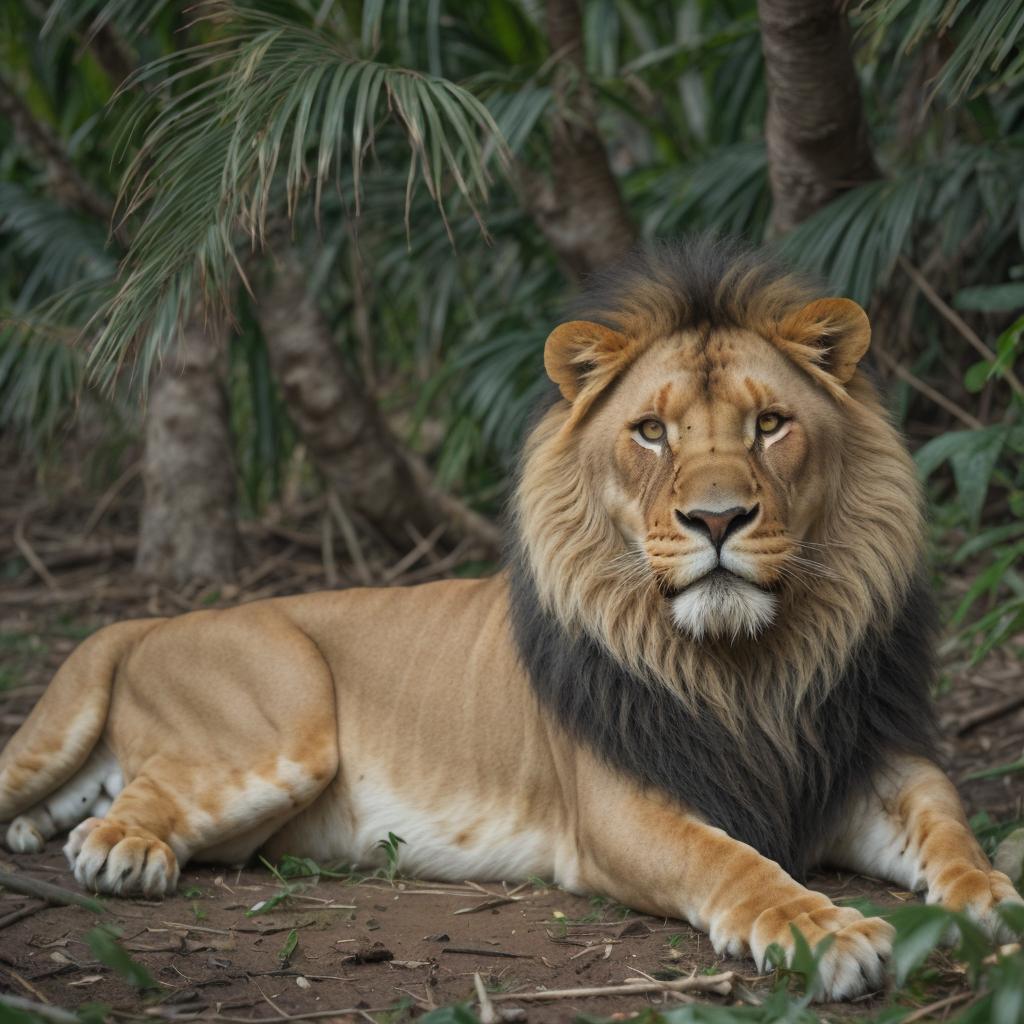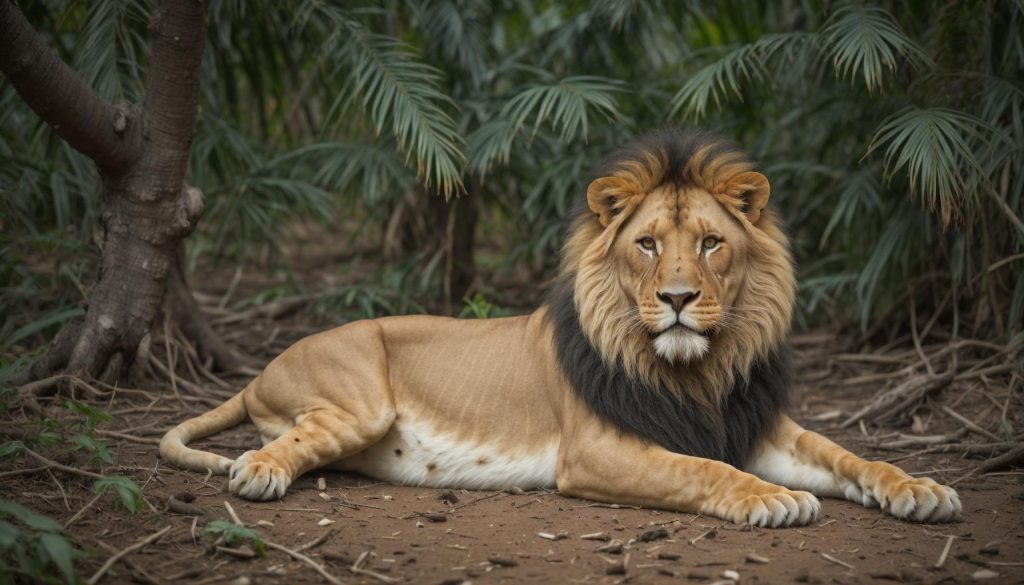Life of a Lion in the Jungle
Introduction:
Nestled within the heart of the jungle, amidst the rhythmic harmony of nature, unfolds the captivating saga of the “Life of a Lion in the Jungle.” Contrary to widespread belief, these majestic creatures aren’t confined solely to savannahs; astonishingly, some thrive amidst the lush landscapes of rainforests. This article immerses you in the enthralling odyssey of these regal beings, shedding light on their habitats, hunting behaviors, and the profound symbolic meaning embedded in their title as the “King of the Jungle.”
1-Life of a Lion in the Jungle: Lions Discovered in Rainforests
Revealing the extraordinary, the life of a lion in the jungle includes surprising discoveries of lions thriving in rainforests, highlighting their remarkable adaptability to diverse environments. The existence of these majestic creatures in lush ecosystems prompts inquiries into the distinctive adaptations that empower them to navigate the challenges of life in the rainforest.
2-King of Jungle 10 Fun Facts about Lions
A :Social Royalty: Lions are highly social animals, living in groups called prides, which typically consist of related females and their offspring.
B :Majestic Males: Male lions are recognized by their impressive manes, a symbol of strength and dominance. The darker and fuller the mane, the healthier the lion.
C: Roaring Kings: Lions are the only big cats that roar, and a lion’s roar can be heard up to five miles away, signaling their dominance and marking territory.
D: Powerful Paws: Lions have retractable claws like domestic cats, but their powerful paws enable them to take down prey with a swift and precise strike.
E: Family Protectors: While females do most of the hunting, male lions guard the territory and protect the pride from potential threats, showcasing a collaborative family structure.
F: Territorial Markers: Lions use scent marking to establish and defend their territory. Male lions have scent glands on their paws and faces for this purpose.
G: Fast and Agile: Despite their size, lions can run at speeds of up to 50 miles per hour and leap distances of 36 feet, making them agile and formidable predators.
H: Versatile Diet: Lions are opportunistic feeders, consuming a variety of prey, including wildebeest, zebras, and even smaller mammals like hares and birds.
I: Nocturnal Predators: Lions are primarily nocturnal, engaging in most of their hunting and activities during the night, taking advantage of their excellent night vision.
J: Playful Cubs: Lion cubs engage in playful activities that mimic adult behaviors, helping them develop crucial skills for hunting and socializing within the pride.
3- Do Lions Live in the Jungle? Learn Where They Live
Contrary to popular belief, lions do not typically live in jungles. Lions are predominantly found in grasslands, savannahs, and open woodlands. Their habitats are characterized by a mix of open spaces and sufficient vegetation, providing opportunities for hunting and establishing territories. While they may not be jungle dwellers, lions showcase adaptability, thriving in various ecosystems across Africa and even parts of Asia. Understanding the actual habitats of lions adds depth to our knowledge of these majestic creatures’ lifestyles.
4- How Lions Came to Have the Title – “The King of the Jungle”
The title “King of the Jungle” bestowed upon lions has a historical and symbolic significance. Despite lions not being exclusive jungle inhabitants, the title likely originated from their majestic appearance, dominant behavior, and historical associations. In ancient cultures and folklore, lions have been portrayed as symbols of strength, courage, and royalty. As the apex predators in their habitats, lions garnered respect and admiration, earning them the regal title of the “King of the Jungle.” This symbolic representation has persisted through time, shaping the perception of lions as majestic rulers of the wild. Understanding the origins of this title adds a layer of cultural and historical context to the fascinating life of a lion in the jungle.

5- What Kind of Habitat Do Lions Live In?
Lions, despite not exclusively residing in jungles, exhibit a diverse range of habitat preferences. Understanding the specific environments where these majestic creatures choose to establish their territories adds a layer of intrigue to the captivating life of a lion in the jungle, and in the wild, lions can be found in various habitats, including savannahs, grasslands, and even rainforests. Their adaptability to different surroundings showcases their prowess as apex predators. The choice of habitat is influenced by factors such as prey availability, water sources, and the need for suitable denning sites.
6- Where Do Lions Actually Live?
Contrary to common perception, the life of a lion in the jungle is not a solitary tale. Lions, the majestic rulers of the wild, establish their domains in various environments. While they’re not exclusive jungle dwellers, lions can be found in diverse habitats, including savannahs, grasslands, and even rainforests, and the intricacies of their chosen residences provide a fascinating glimpse into the life of a lion in the jungle, showcasing adaptability and resilience. From the open plains to the lush greenery of rainforests, these regal creatures navigate different terrains, embodying the essence of the wild and the captivating title of “King of the Jungle.”
7- Which Creature Reigns as the True Monarch of the Jungle?
When contemplating the title of the true king of the jungle, the spotlight invariably falls on the majestic lion. Despite not exclusively residing in jungles, the life of a lion in the jungle reveals a captivating narrative of regality, dominance, and survival. Lions, with their commanding presence and symbolic significance, emerge as the undisputed rulers, embodying the essence of the wild with unparalleled grace and ferocity. The journey of the life of a lion in the jungle unveils the true monarchs of the untamed landscapes.
8- What are the 7 Species of Lions?
In the intricate tapestry of the wild, there exist not one, but seven distinct species of lions, each contributing to the captivating narrative of the life of a lion in the jungle.
-
African Lion
The iconic savannah dweller, the African lion, symbolizes strength and resilience. Its majestic presence is central to the imagery of the wild.
-
Asiatic Lion
Thriving in the diverse landscapes of Asia, particularly the Gir Forest in India, the Asiatic lion boasts unique characteristics, contributing to the rich biodiversity of the jungle.
-
Barbary Lion
Once found in North Africa, the Barbary lion is a historical species, adding a touch of ancient mystique to the life of a lion in the jungle.
-
West African Lion
In the lush habitats of West Africa, this lion species reveals adaptations to its specific environment, showcasing the dynamic nature of jungle life.
Roaming the East African savannahs, the Masai lion brings a distinct flair to the narrative, embodying the resilience required for survival in diverse landscapes.
-
Transvaal Lion
Found in the southern regions of Africa, the Transvaal lion adds to the mosaic of lion species, highlighting the adaptability and range of these majestic creatures.
-
Katanga Lion
Navigating the landscapes of Southern Africa, the Katanga lion represents the intricate variations within the lion family, contributing to the vibrant life of a lion in the jungle.
9- What Do Lions Eat, and Where Do They Find Food?
In the intricate tapestry of the life of a lion in the jungle, understanding their dietary habits is crucial. Lions are apex predators with a diverse palate, feasting on herbivores like wildebeests and zebras. This dietary diversity ensures their survival in the ever-changing landscapes they call home. From the open savannahs to the lush jungles, lions showcase their prowess as skilled hunters, maintaining the delicate balance of life in the wild.
10- How Do Lions Hunt and What Are Their Prey?
Lions are formidable hunters, employing a combination of speed, strength, and strategy to secure their prey. Their cooperative hunting style, often observed in prides, enhances their chances of success. While the specific prey may vary, depending on the region and availability, lions commonly target ungulates such as wildebeests, zebras, and antelopes. This efficient hunting approach ensures the sustenance of the pride, highlighting the remarkable hunting prowess of these apex predators in the jungle.
11- Female Lions Do Most of the Hunting
In the lion kingdom, a surprising twist unfolds – it’s the lionesses who take charge in the hunting arena. Contrary to expectations, female lions play a dominant role in securing food for the pride. This unique dynamic not only challenges traditional gender norms but also showcases the strategic prowess and cooperation within the pride. Witness the power of the lionesses as they skillfully navigate the wild, embodying the essence of teamwork in the pursuit of survival.
12- What is Lifelike for a Lion Cub?
The life of a lion cub is a whirlwind of discovery, play, and learning. From the moment of birth, these young members of the pride embark on a journey filled with challenges and growth. Nurtured by their mothers, lion cubs experience the world around them, shaping the future rulers of the jungle.
13- How Does a Lion Defend Its Territory?
A lion defends its territory with strategic prowess. Utilizing a combination of roaring, scent marking, and occasional confrontations, these majestic creatures ensure the safety and prosperity of their pride. The lion’s territorial defense reflects its instinctual commitment to safeguarding its kingdom in the jungle.
14- What Do Lions Do for Fun?
Lions, in their moments of leisure, engage in various playful activities. From mock fights to social bonding, these majestic creatures exhibit a lighter side, revealing the joy and camaraderie that punctuates their complex lives in the jungle.
Conclusion:
In summary, the life of a lion in the jungle is a tapestry woven with complexity, adaptability, and regal splendor. From rainforests to savannahs, from hunting to playful antics, these creatures embody the essence of the wild. Understanding their habitats, behaviors, and the symbolic significance of their title enriches our appreciation for the true kings and queens of the jungle.
FAQ:
1-What is the lifestyle of a lion in the jungle?
The lifestyle of a lion in the jungle is marked by regal behaviors, social structures within prides, hunting for survival, and territorial defense. Understanding their dynamic lifestyle provides insights into the complex nature of these majestic creatures.
2-What are 5 interesting facts about lions in the jungle?
In the jungle, lions exhibit fascinating behaviors, such as surprising adaptability to rainforests, engaging social interactions within prides, unique hunting strategies, and playful recreational activities. Discovering these facts adds depth to our understanding of their lives.
3-What is the life process of a lion in the jungle?
The life process of a lion in the jungle encompasses various stages, from birth and early development to hunting, forming pride, and defending territories. Exploring this life process offers a comprehensive view of how these creatures navigate their jungle habitats.
4-How long do lions live in the wild in the jungle?
Lions in the wild jungle environments have a lifespan influenced by factors like territory, availability of food, and natural challenges. Understanding the factors affecting their longevity provides valuable insights into the realities of their wild existence.

[…] To know about Life of a Lion in the Jungle read this article […]
[…] masai lion facts […]